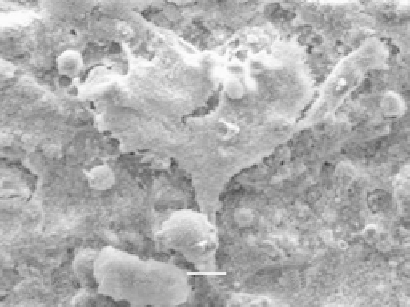Biomedical Engineering Reference
In-Depth Information
HA, it is interesting to note that the precipitated apatite microcrystals appeared by second-
ary nucleation and were aggregated around ceramic crystals in bone sites (Rohanizadeh et
al. 1999). Available TEM results showed that both HA crystals and precipitated microcrys-
tals had the same D-spacing and the same apatite structure (Rohanizadeh et al. 1999).
Previous study revealed that bioactivity of as-sprayed coatings, especially coating sur-
face bioproperty (Kido et al. 1997), and mechanical properties significantly influenced
their functional service in the long run. HA coatings have a favorable effect on bone appo-
sition on the implant and give evidence that this is due to early adhesion of osteoblasts and
direct deposition of bone matrix on the HA substrate (Pazzaglia et al. 1998). This proves
the importance of early dissolving of HA coating. However, previous studies have raised
some concerns regarding the resorption, fracture, fatigue, or macrobiological susceptibil-
ity for HA coatings. It should be emphasized that the characteristics of all HA coatings are
not always the same, and this may affect the chemical, physical, and mechanical proper-
ties of the implants.
Natural HA formed in-bone is initially deposited in the collagen matrix of the bone in a
relatively amorphous form that appears to mature into a more crystalline form (Szivek et al.
1996). Perhaps the lower level of crystallinity encourages bone attachment at a faster rate ini-
tially because they mimic the naturally occurring newly formed HA surface or because they
undergo some resorption that provides an uncontaminated surface for bonding. The rela-
tively amorphous coatings provided better bonding (Szivek et al. 1996). Generally, adhesion
of cells to a biomedical coating is believed to involve several steps: adsorption of proteins
onto coating surface, attachment of cells by recognizing the adsorbed proteins, spreading
of cells, growth/proliferation/differentiation of cells (Silver et al. 2000; Meyer et al. 2006).
Adhesive interactions between cells or cells and the extracellular matrix are thought to play
an essential role in several biological processes, including cellular recognition, specification
and signaling, provision of positional cues during vertebrate development, cell proliferation
and differentiation during wound healing, and leukocyte adherence and emigration.
There has been no doubt that HA and HA-based composites are capable of enhanc-
ing attachment and proliferation of viable cells (Deligianni et al. 2001; Rose et al. 2004;
Carey et al. 2005; Hossain et al. 2005; Knabe et al. 2004; Xie et al. 2004). Fast attachment
and proliferation of osteoblast cells on thermal-sprayed HA coatings have been evidenced
(Figure 4.37) (Li et al. SCT, 2006).
10 kV ×1200 10 µm 20 38 SEI
FIGURE 4.37
Typical SEM picture showing the osteoblast cell attached on the HA coating. (From Li et al.,
J. Therm. Spray
Technol
., 15, 610-616, 2006. With permission.)

Search WWH ::

Custom Search